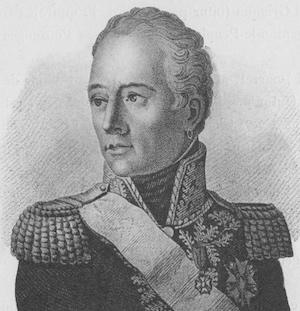General Louis-Marie Turreau de Garambouville

Born: July 4, 1756
Place of Birth: Evreux, Eure, France
Died: December 10, 1816
Place of Death: Conches, France
Arc de Triomphe: TURREAU on the east pillar
Pronunciation:
Coming from a bourgeois background, Louis-Marie Turreau de Garambouville had only limited military experience before the Revolution. In November of 1791 he joined the National Guard of Conches and the following April he became their commander. Turreau was next elected a lieutenant colonel of the 3rd Battalion of Volunteers of Eure in September of 1792 and he went on to serve in the Army of the North and the Army of the Ardennes. 1793 was a very busy year for Turreau, for in June he fought at Arlon and then at the end of July he was assigned to the Army of the Coasts of La Rochelle and promoted to général de brigade. That September Turreau fought at Doué and afterwards he received another promotion, this time to général de division. Next he was named commander of the Army of the Eastern Pyrenees in October and after taking command he led this army in a failed attack on the camp of Boulou.
Turreau's time with the Army of the Eastern Pyrenees was short, for in November of 1793 he was sent to the Army of the West and then named commander-in-chief of the Army of the West. After taking up his command in December, he set out to quell the rebellion in the Vendée. In January of 1794 Turreau seized Noirmoutier and then organized the famous infernal columns in the Vendée to destroy resistance to the French Republic. Five months later in May he was suspended from this command and named commander at Belle-Isle-en-Mer. Turreau remained at Belle-Isle-en-Mer until September when he was relieved of duty and then arrested. Released in November, he was acquitted in December but did not take up an active command again.
General Turreau returned to campaigning in September of 1797 when he was employed in the Army of the Sambre and Meuse. In January of 1798 he was assigned to the Army of Mainz and he took command of the 4th Division. The next year Turreau was given command of the departments of Mont Tonnerre and Sarre, and then in August he took command of the 1st Division of the Army of Switzerland. He briefly commanded the army in November and December while awaiting the arrival of General Moreau, and then in December he was sent to the Army of Italy. In March of 1800 Turreau took command of the left wing of the Army of Italy, and then in April his force was detached to serve with the Army of the Reserve. That May he and his men seized the pass of Suse but then they were repulsed at Avigliana.
With peace finally obtained, Turreau was sent to the isle of Elba in April of 1801. That October he was sent to Switzerland to oversee Bas-Valais, and then in 1803 he was appointed ambassador to the United States. Turreau was named a Grand Officer of the Legion of Honor in 1804 and he remained as ambassador to the United States until 1811. After returning to France, in 1812 he became the Baron of Linières.
In 1813 Turreau took command of the 21st military division at Bourges and then in July he joined the Grande Armée, taking command of the 51st Infantry Division and serving as part of Marshal Augereau's IX Corps. Turreau was assigned command of Wurzburg in August of that year, and in October he was forced to fall back to the city's fortress. Besieged by Allied forces, he held Wurzburg until well after Napoleon's abdication in April of 1814, finally surrendering the city in May. Returning to France, the Bourbons put Turreau on non-activity. He did not take an active part in the Hundred Days of 1815 and afterwards he officially retired from the army.
Bibliography
Updated September 2015
© Nathan D. Jensen